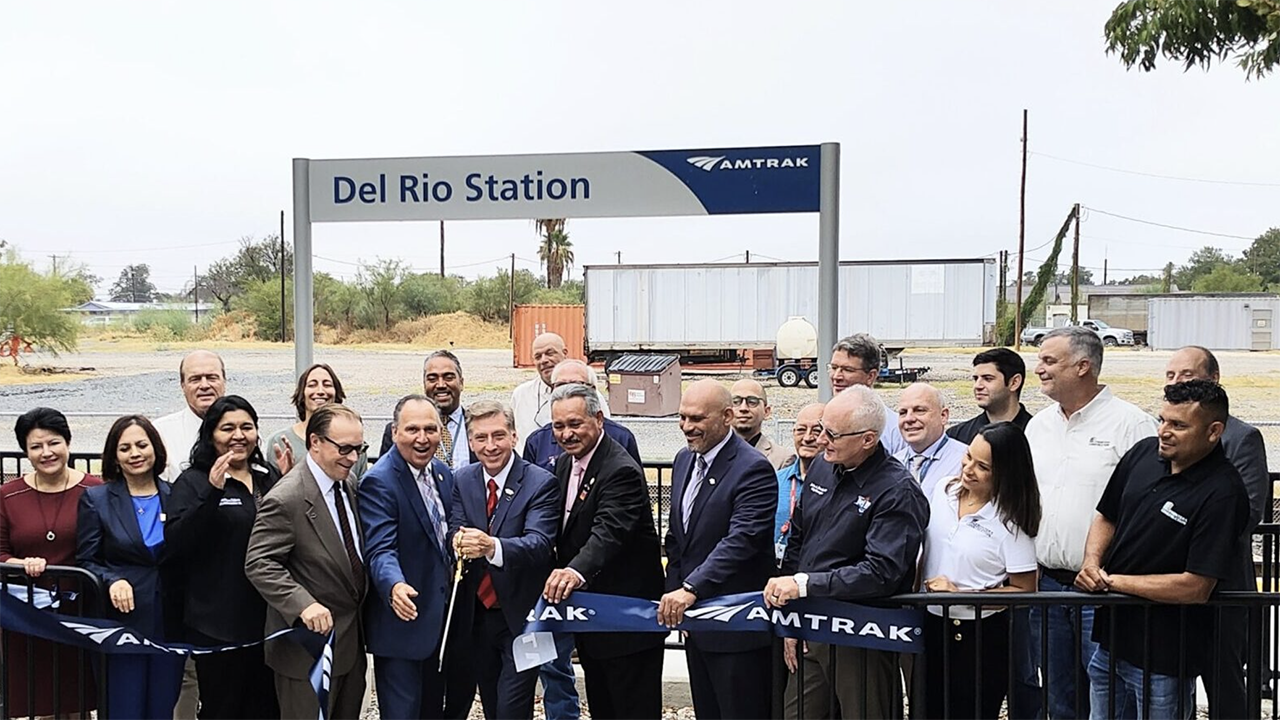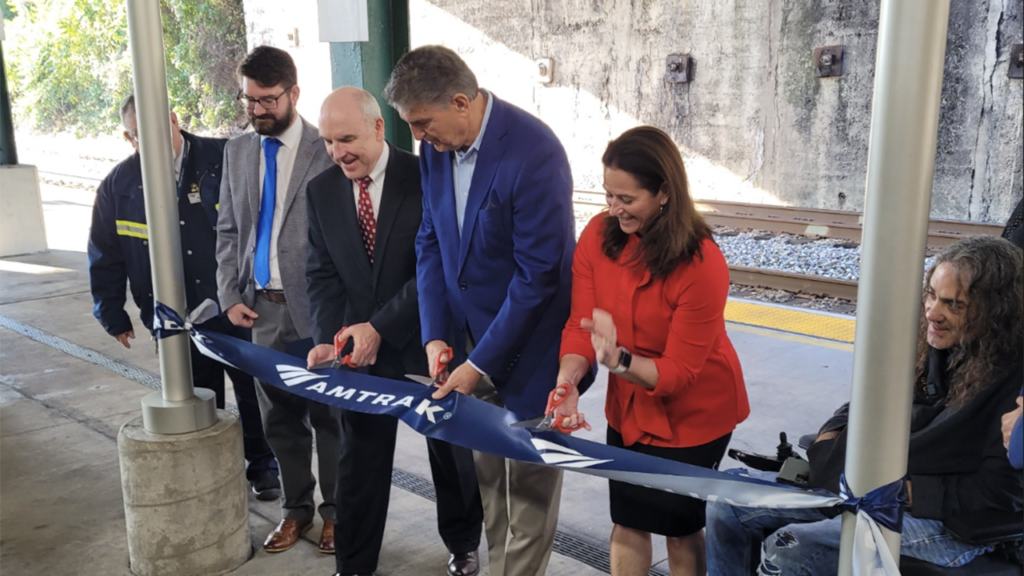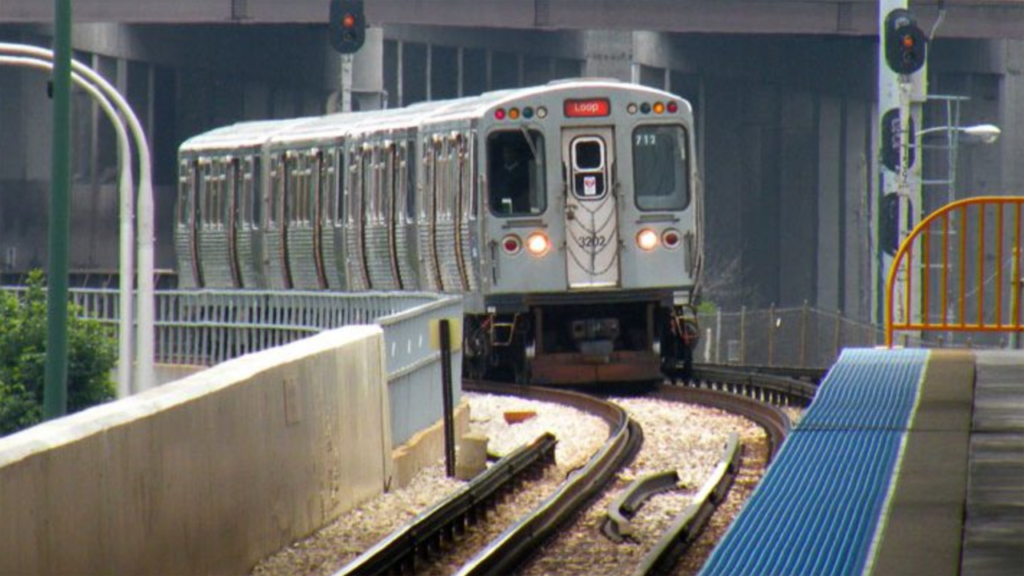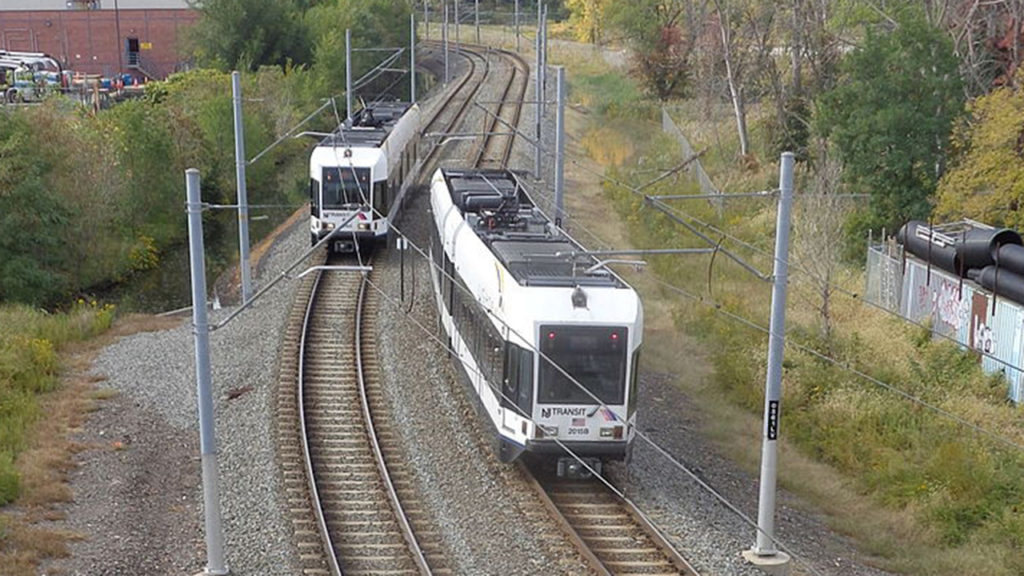
Transit Briefs: Amtrak, CTA, LACMTA, NJ Transit
Written by Marybeth Luczak, Executive Editor
Accessibility upgrades were celebrated at Amtrak’s Del Rio station in Texas. (Amtrak Photograph)
Amtrak completes station accessibility upgrades in Texas and West Virginia. Also, ridership growth at Chicago Transit Authority (CTA) continues into September; Los Angeles County Metropolitan Transportation Authority (LACMTA) celebrates a $38.2 million grade separation project grant from the Federal Railroad Administration (FRA); and New Jersey Transit debuts contactless fare payment for light rail and bus riders.
Amtrak

Amtrak has completed accessibility projects at the Del Rio, Tex., and Charleston, W.Va., stations.
The Sunset Limited, which travels three days weekly between New Orleans, La., and Los Angeles, Calif., includes a stop at Del Rio, the county seat of Val Verde County, along the southwestern U.S. border with Mexico. As part of a $3.8 million project, Amtrak and the city invested in the construction of a 650-foot-long concrete platform and upgrades to station signage. A mobile lift enclosure, parking stalls, public right-of-way access, and energy-efficient LED light fixtures along the platform and pathways were among the other improvements meeting Americans with Disabilities Act (ADA) specifications. According to Amtrak, walkways connect the platform to the city-owned Del Rio Regional Transportation Center, which accommodates Amtrak, local buses and taxis.
“Making Amtrak stations accessible to all customers is a priority and we’re actively performing construction, renovation, repair and upgrade projects at stations across our national network,” Amtrak Assistant Vice President George Holz said at the Oct. 10 ribbon-cutting ceremony, marking the Del Rio project’s completion. “We want Del Rio and all of our stations to be a welcoming and comfortable environment to all of our customers.”
Amtrak also upgraded the Charleston station, a stop for its Cardinal service that operates three times per week from New York and Chicago.
The $6.4 million project included a new 800-foot-long concrete platform featuring new lighting, guardrails, signage, and stormwater system. The platform is located alongside the historic station building and extends underneath the Southside Bridge. Additional improvements included the creation of pathways extending from both parking lots to the station, and three accessible parking spaces for customers. Bird netting was also installed in the roadway bridge structures above the platform to help maintain a clean environment.
The station building has two new entrances, a renovated waiting room and restrooms, Amtrak said. A new fire system was installed, and the heating, ventilation and air condition system was updated. Crack repairs were made to the building’s exterior walls and a new roof was provided.
According to Amtrak, the work was performed in coordination with the FRA, CSX, West Virginia Division of Culture and History, West Virginia Department of Highways, and the city of Charleston.
Since 2011, Amtrak has invested nearly $800 million in accessibility upgrades and improvement projects at 119 stations across the national network that it said will “ensure a safe, efficient, and comfortable travel experience for customers with disabilities.” The improvements include repairs and upgrades to platforms, ramps, and sidewalks, and renovations to entranceways and restrooms, with 20 stations brought into ADA compliance last year. Another 35 stations are targeted for completion this fiscal year, “America’s Railroad” said, at a forecasted investment of $125 million.
Amtrak’s program is advancing 143 station designs and 39 station construction projects and the railroad said it is working toward 100% completion by 2029.
CTA

CTA on Oct. 11 reported seeing continued ridership growth as more riders return to the system on a post-pandemic, daily basis. In September, it provided 25.83 million rides, building off what it called a “strong summer.” The transit agency provided more than one million rides on 12 days in August and September, with nine of the highest ridership days occurring last month. Students returning to classrooms for the 2023-24 school year helped contribute to this ridership jump, CTA said, as the fall months are typically the highest ridership months.
“This ridership growth is a testament to the progress we’ve made across the system over the past year—but we still have more work to do,” CTA President Dorval R. Carter Jr. said. “Over the next year I’d like to see that million-ride mark become the standard.”
LACMTA
LACMTA on Oct. 11 reported celebrating a $38.3 million FRA grant for its Doran Street Grade Separation Project, which it said will improve safety at a crossing that has one of the highest numbers of safety-related incidents involving vehicles, bicycles or pedestrians in Los Angeles County. The funding is through FRA’s Railroad Crossing Elimination Grant Program, and FRA Administrator Amit Bose visited the project site to present the award that was announced earlier this year.
The project includes building a grade-separated structure that links Los Angeles and Glendale by connecting West San Fernando Road to the Fairmont Avenue bridge, closing the at-grade crossing, and improving the rail corridor, which is used by Metrolink and Amtrak to carry eight million riders per day and by freight trains. Up to 90 trains per day use the tracks in this area, LACMTA reported, and train volumes are anticipated to increase to 116 trains per weekday by the time the project is completed in 2027. The Doran Street Grade Separation Project is part of LACMTA’s Regional Rail Program, which leads the planning, design and construction of capital improvements along 140 miles of LACMTA-owned rail right-of-way.
The grant will allow LACMTA to begin construction in 2025. The transit agency said it is providing a 28% local funding match to help pay for the $61.8 million project. Now that the project is fully funded, construction scheduling can officially begin, it noted.
A second $220.7 million project phase will build a nearby overpass at Salem and Sperry streets in Glendale, according to the transit agency. This project element is slated to increase non-motorized access to employment, residences and recreational opportunities in an area that is currently blocked by the Los Angeles River and the 134 Freeway.
“As a longtime proponent of the Doran Street Grade Separation project, I want to wholeheartedly thank FRA Administrator Amit Bose for providing $38 million in federal funding for this crucial safety project,” Los Angeles County Supervisor and LACMTA and Metrolink Board Member Kathryn Barger said. “I valued holding a productive dialogue with Administrator Bose previously this year in Washington, D.C. I commend the FRA for directing Railroad Crossing Grant dollars to the Doran Street Grade Separation project. It will undoubtedly result in far-reaching improved safety for Metrolink, Amtrak, and freight trains operating in the cities of Los Angeles and Glendale.”
NJ Transit

NJ Transit is now offering light rail and bus riders a “Tap & Ride” payment option that allows them to use contactless credit and debit cards with the existing validators.
The transit agency said the program has begun with adult one-way tickets on all three light rail lines as well as on buses (except A&C and O.N.E. emergency stabilization service at this time) and will be expanded to accept payment for more ticket types soon.
Light rail customers simply tap their contactless card at the station validator to pay for their fare. Fare enforcement officers have mobile scanners and will ask a customer to tap the same card used to purchase their ticket to validate proof of payment, according to NJ Transit.
“As part of our ongoing efforts to leverage technology to improve the customer experience, NJ Transit is pleased to launch ‘Tap & Ride,’” NJ Transit President and CEO Kevin S. Corbett said. “This new fare payment option will not only be more convenient for customers, but it will speed up the boarding process by reducing onboard transaction times.”



